Judith Works's Blog, page 10
January 26, 2013
HAITI BEFORE THE EARTHQUAKE
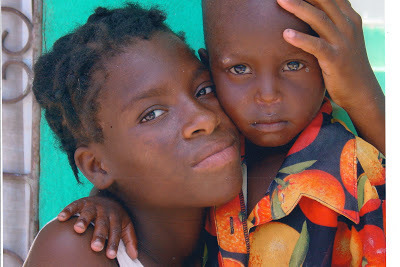
Not too long before the terrible earthquake that struck Haiti I had occasion to visit on behalf of the United Nations. Now when I look back I see that Port-au-Prince was paradise compared with current conditions with the lack of housing, education and jobs, and the presence of cholera increasing the suffering resulting from their tragic history.
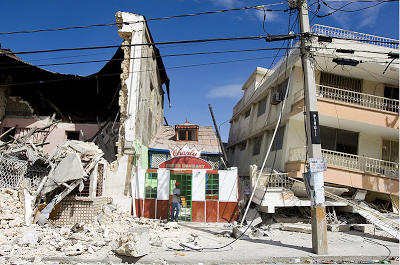
* * *
The airport in Port-au-Prince was a madhouse. Suitcases tied with string, plastic bags and cloth-wrapped bundles circled the conveyor belt. Aid workers, dressed in jeans and safari shirts; preachers, nuns and priests in their conservative garb; returning members of the Haitian diaspora greeting their family members, all competed to claim their baggage and get out of the crowded arrival hall. French and Creole music blaring from boom boxes added to the din.
On the way to Pétionville, a suburb south of the main city where my hotel was located, I peered out the windows of the air-conditioned SUV. Before me was a scene of burned out cars, mangy dogs, pigs, goats and people rooting in piles of rotting garbage, crumbling or half-built concrete buildings with tin roofs housing tiny indigenous protestant churches or small stores and repair shops. A few schoolgirls in uniform passed groups of men in tattered clothing idling alongside the road. Women with baskets or bowls on their heads walked along.
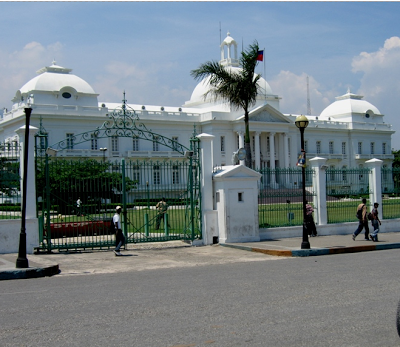 The city appeared to be one huge African slum dotted with a few exceptions like the white Presidential Palace and the main cathedral. “Where does anyone with money live?” I asked. My escort pointed to steep hills overlooking the city where the lighter skinned resided in gated estates near their exclusive shops for French pastries, food, wine and clothes, unthinkable luxuries for their blacker brethren in this country where,he said, skin color is closely observed.
The city appeared to be one huge African slum dotted with a few exceptions like the white Presidential Palace and the main cathedral. “Where does anyone with money live?” I asked. My escort pointed to steep hills overlooking the city where the lighter skinned resided in gated estates near their exclusive shops for French pastries, food, wine and clothes, unthinkable luxuries for their blacker brethren in this country where,he said, skin color is closely observed.It was pleasant sitting on the beautiful terrace of the Hotel Montana high above Port-au-Prince awaiting a ride to the office. That is, until I looked at the city spread out below in all its misery. Dust from the unpaved roads hovered in the air mingling with smoke from burning garbage rising in plumes in the hot air, an earthly vision of Dante’s Inferno and its circles of hell. The hotel was half-way up one of the hills neatly placed between the verdant heaven of the few rich and the crumbling hell of the vast numbers of poor. Favored by the few tourists on group tours and many aid workers, it had spectacular grounds with purple and orange bougainvillea, enormous hardwood trees, ponds filled with fish and tropical plants, a swimming pool, bar and dining room on the terrace serving Creole food. Open air public rooms were filled with Haitian paintings depicting idyllic scenes in magical realism style: well-fed people, forested hillsides and tropical scenes, fantasies all. Large flower arrangements with bird of paradise, anthurium and helicona graced the tables. African-looking Haitian sculptures stood in corners. Sofas and lounge chairs made of dark tropical hardwoods in Art Deco style invited guests to rest in while awaiting their rides.
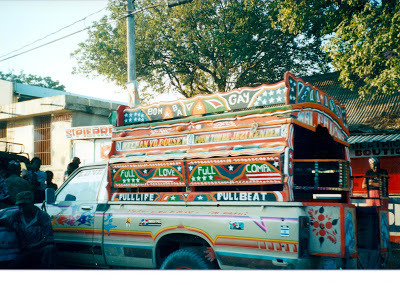 The road to the office from the hotel led along steep, narrow, winding, unpaved pot-holed roads. Women were selling a few fruits and vegetables spread on the ground and urchins tried to polish shoes or sell packets of tissue or gum. Occasionally, a man had a display of tin sculptures for sale. Pickups made into mini-buses hurried by loaded with people. The colorful vehicles were painted with slogans and designs. One had “Full Life, Full Love, Full Beat, Full Compa” along with “Bomba” and “Gay.” Rounding out the decorative scheme was a painted Israeli flag, various Chinese characters, stars, flowers and waves. The colors seemed a demonstration of defiance against the drab sea of crushing poverty.
The road to the office from the hotel led along steep, narrow, winding, unpaved pot-holed roads. Women were selling a few fruits and vegetables spread on the ground and urchins tried to polish shoes or sell packets of tissue or gum. Occasionally, a man had a display of tin sculptures for sale. Pickups made into mini-buses hurried by loaded with people. The colorful vehicles were painted with slogans and designs. One had “Full Life, Full Love, Full Beat, Full Compa” along with “Bomba” and “Gay.” Rounding out the decorative scheme was a painted Israeli flag, various Chinese characters, stars, flowers and waves. The colors seemed a demonstration of defiance against the drab sea of crushing poverty.The blue UN flag was flying at their offices. I had been asked to review some organization issues and to assess a personnel problem. The organizational issues were routine but the personnel problem was unique. Without going into details I’ll say that it involved a culture clash and threats of a voodoo spell – not the typical personnel problem.
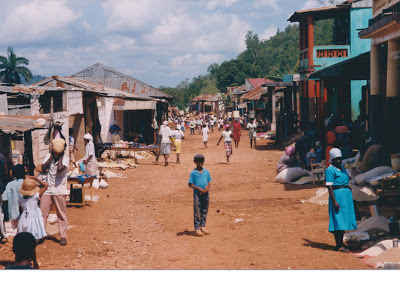 It was time to leave on the next leg of the trip. The itinerary was to travel first to Santo Domingo, the capital of the Dominican Republic, on the other half of the island of Hispaniola and then on to Nicaragua via Miami for the final stop. Even though we had less than 200 miles to drive, it was a long day’s journey. A two-car convey showed up at the hotel at sunrise. The vehicles were equipped with several radios and sported impressive antennae waving in front of the windshields. Their presence suggested danger.
It was time to leave on the next leg of the trip. The itinerary was to travel first to Santo Domingo, the capital of the Dominican Republic, on the other half of the island of Hispaniola and then on to Nicaragua via Miami for the final stop. Even though we had less than 200 miles to drive, it was a long day’s journey. A two-car convey showed up at the hotel at sunrise. The vehicles were equipped with several radios and sported impressive antennae waving in front of the windshields. Their presence suggested danger. 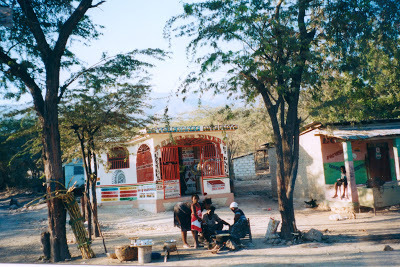 But it was peaceful as we passed hamlets with people squatting outside their huts cooking food over charcoal, the only fuel readily available and the reason for the denuded and flood-prone hillsides where the charcoal makers cut down the trees that others had planted in an effort at reforestation. Cemeteries with half-built mausoleums of tile, drug lord compounds and tiny stores with “Articles Divers” painted above the grilled doorway lined the roadway. Barefoot women with baskets on their heads leading laden horses and mules walked on unpaved side roads.
But it was peaceful as we passed hamlets with people squatting outside their huts cooking food over charcoal, the only fuel readily available and the reason for the denuded and flood-prone hillsides where the charcoal makers cut down the trees that others had planted in an effort at reforestation. Cemeteries with half-built mausoleums of tile, drug lord compounds and tiny stores with “Articles Divers” painted above the grilled doorway lined the roadway. Barefoot women with baskets on their heads leading laden horses and mules walked on unpaved side roads. When we arrived at Lake Azuei on the border crossing at Jimani, a long line of trucks and pickups waited. A boy in a red, yellow and blue boat poled along the lake bringing sacks of charcoal to market. A rickety table and two chairs sat in the dust in front of a blue and white painted mailbox near the custom house. The iron-grilled gate marking the border was closed for inexplicable reasons, a frequent occurrence, and reflective of the Dominicans profound dislike and distrust of Haitians. Almost all food in Haiti is imported and these waiting trucks with their frustrated drivers were trying to get across the border to pick up produce. Brightening the chaotic scene, the vehicles sported the same colorful paint jobs as in Port-au-Prince. A dust covered truck behind us in the lineup said “Immaculee” over the cab and “Exode 14” and “Generation de L’An 2002” on the sides.
Nothing was moving. My driver went to the border post to try to get my laisser passer (UN passport) stamped for exit. No dice. After 45 minutes of no action, he drove around the lineup. Seeing the blue “UN” painted on the white SUV, the Dominican authorities opened the gate and stamped my passport even without the required Haitian exit stamp. Our escort turned back.
* * *
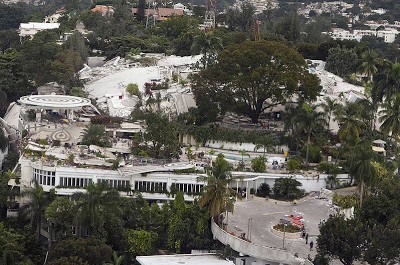 The earthquake caused the collapse of the Hotel Montana, entombing the staff and over two hundred guests, many of whom were aid workers.
The earthquake caused the collapse of the Hotel Montana, entombing the staff and over two hundred guests, many of whom were aid workers.* * *
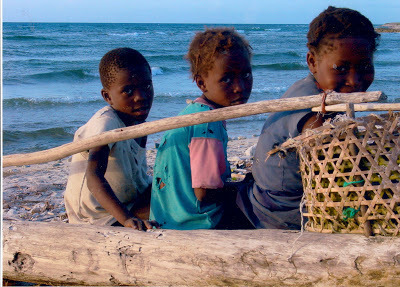 I treasure three photos given to me by a doctor. The first is a beautiful mother and child (shown at the top of the post), second is of three delightful children, happy in spite of poverty.
I treasure three photos given to me by a doctor. The first is a beautiful mother and child (shown at the top of the post), second is of three delightful children, happy in spite of poverty.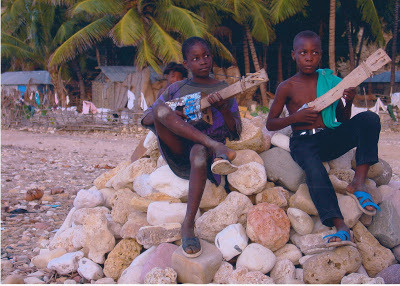 The third, two boys dressed in rags sitting on a pile of rocks in front of hovels with corrugated tin roofs shaded by palm trees. They are pretending to play guitars, each made of a board, two pegs and two strings. Whatever music was made, they represent an indomitable will to survive in that often sad place. I pray that they are still alive.
The third, two boys dressed in rags sitting on a pile of rocks in front of hovels with corrugated tin roofs shaded by palm trees. They are pretending to play guitars, each made of a board, two pegs and two strings. Whatever music was made, they represent an indomitable will to survive in that often sad place. I pray that they are still alive.
Published on January 26, 2013 11:20
January 1, 2013
THE GAMBIA
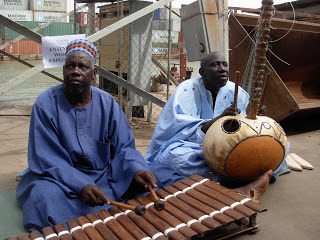
The mellow sound of a marimba and harp-like kora welcomed us to Banjul, the capital of The Gambia. It was a Friday in this heavily Moslem country. Prayers were finishing at mosques, which despite being in abundance, were insufficient in size so that even gas stations were used for worshippers. Later, streets and walkways were filled with men walking home with rolled up prayer mats under their arms while holding on to their little boys’ hands.
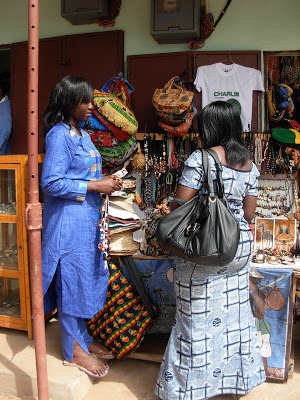 Women wore long dresses often in blue or mauve but even men were brilliant in their canary yellow, magenta, saffron, teal and lime green tunics, contrasting colored pants and pointed backless slippers. The passing scene was typically African with goats, broken pavements, tiny shops, a colorful central market, ambulatory traders and oh so many children, although instead of the red dirt and palm trees found farther south, Sahara sands dusted the scene and greenery was in short supply.
Women wore long dresses often in blue or mauve but even men were brilliant in their canary yellow, magenta, saffron, teal and lime green tunics, contrasting colored pants and pointed backless slippers. The passing scene was typically African with goats, broken pavements, tiny shops, a colorful central market, ambulatory traders and oh so many children, although instead of the red dirt and palm trees found farther south, Sahara sands dusted the scene and greenery was in short supply. The tiny country lining the lower reaches of the river Gambia is the smallest in Africa and is surrounded by French-speaking Senegal. It is an English-speaking remnant of British colonialism, soon apparent when we drove by the dilapidated-looking and now misnamed Queen Victoria Teaching Hospital. Always intrigued by colorful signage in Africa, the first one to catch my attention was on the hospital; it proclaimed that “Allah is the Greatest.” The next sign, along the wall next to the hospital, brought viewers back down to reality. It said, “avoid urinating here.” The admonition was followed by a man dressed in a blue jacket and white pants sitting at a treadle sewing machine making a woman’s yellow dress.
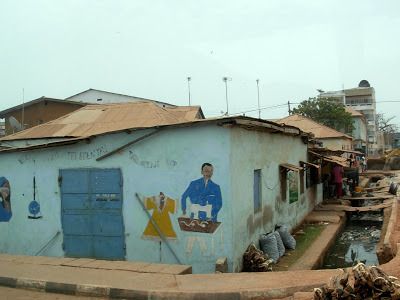
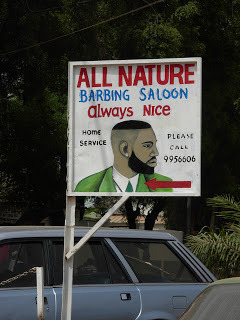 A barbershop sign recommended the “All Nature Barbing Saloon. Always Nice.”
A barbershop sign recommended the “All Nature Barbing Saloon. Always Nice.” 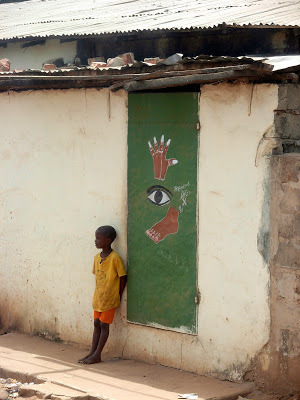
A small boy dressed in orange and yellow leaned against a green door decorated with an ambiguous painting of a hand, eye and foot. Was it a doctor's ad or a fortune teller's message?
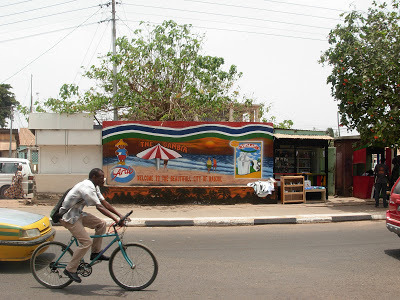 By the museum, full of interesting tribal artifacts and costumes, and instruments from the country’s rich musical heritage, we were greeted with “Welcome to the Beautiful City of Banjul.” Boosterism knows no bounds. Although advertised in Europe as a tourist destination for beaches and bird-watching (“The Smiling Coast of Africa” is their motto), our welcome seemed dubious as several groups of scowling men gestured menacingly and, disconcertingly, boys pounded on girls to grab candy that some tourists attempted to share.
By the museum, full of interesting tribal artifacts and costumes, and instruments from the country’s rich musical heritage, we were greeted with “Welcome to the Beautiful City of Banjul.” Boosterism knows no bounds. Although advertised in Europe as a tourist destination for beaches and bird-watching (“The Smiling Coast of Africa” is their motto), our welcome seemed dubious as several groups of scowling men gestured menacingly and, disconcertingly, boys pounded on girls to grab candy that some tourists attempted to share.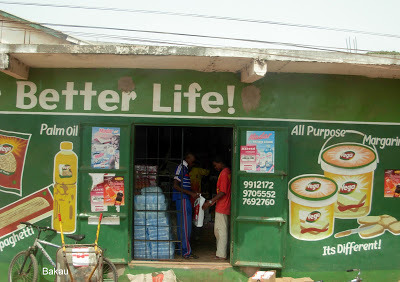
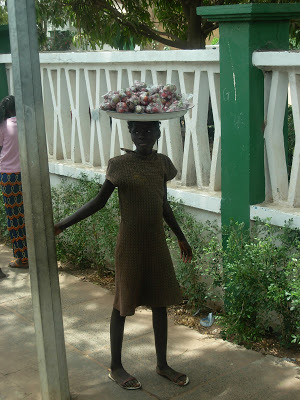
Colorful as the signs and many of the people are, on the whole the scene was discouraging with resigned families sitting idle in garbage-strewn yards while plastic bags flew in the desert breeze like kites. Literacy is low (under 20% for girls); AIDS is a plague; poverty is endemic. Illegal sand mining has severely eroded the coastline while workers on Chinese fishing boats unload tons of tuna for shipment home, the wealth of Africa moving to new colonialists. After all the intensity of day at dusk we watched small fishing boats in the estuary marking their presence solely by the faint lights of charcoal cooking fires. Even that idyllic African scene marked a very tough life. It’s hard to imagine what the populace of such a tiny strip of land could do to pull the country out of poverty. I have visited many poor countries but in Banjul, at least, The Gambia seemed to be the most unlikely to escape third-world status.
And yet ...back home we wandered into a festival put on by the local Gambian association. A famous kora musician and his band were in town for an AIDS benefit. We ran into people who knew some of our friends and received a warm welcome by everyone. We sat to listen to the music and to watch as women and girls in bright sequined gowns and headdresses glitter and sparkle as they danced across the stage while opening their evening bags to extract what seemed like thousands of dollars into a tub. Perhaps the Gambian diaspora will manage to make enough of a difference and Gambia will have a "Better Life" after all.
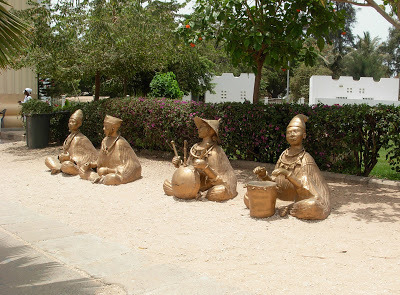
Published on January 01, 2013 11:27
December 13, 2012
BE READY FOR GOOD FORTUNE
A Guest Post by fellow traveler, Janette Turner:
One summer I traveled to Italy with my husband’s business school and set out on a side trip to Venice. My companion was another wife amusing herself while her spouse was in class. As I sat in the back seat of a student's rental car next to Barb, she revealed why all the other wives had gone off without us.
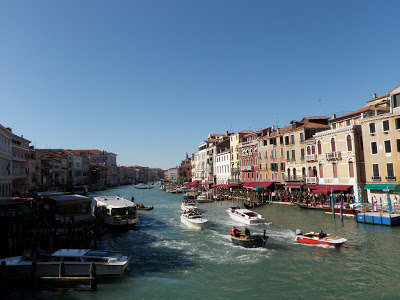 “Slow down!" said Barb every few minutes, even though the young driver was motoring in the right lane, letting cars pass. Soon there were so many admonishments and complaints from Barb that I realized I was reflexively cringing whenever she opened her mouth. She seemed to have the same displeased opinion about everything, including the short ride on the train and the choppy water against the sides of the Vaporetto that finally arrived. Most of all, she complained about her husband. “Martin flirts with the coeds and doesn’t seem to notice me.”
“Slow down!" said Barb every few minutes, even though the young driver was motoring in the right lane, letting cars pass. Soon there were so many admonishments and complaints from Barb that I realized I was reflexively cringing whenever she opened her mouth. She seemed to have the same displeased opinion about everything, including the short ride on the train and the choppy water against the sides of the Vaporetto that finally arrived. Most of all, she complained about her husband. “Martin flirts with the coeds and doesn’t seem to notice me.”
I nodded in sympathy while leading us down the alley to our budget hotel. Opening the door to our room, I was shocked to see a chandelier and gilding on the bathroom fixtures. The floor at my feet was a mosaic of marble. “This room is divine.”
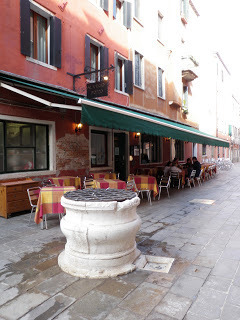 Barb looked around. “It’s dirty,” she said and continued her list of marital complaints. At one point she abandoned the subject to discuss dinner. “I don’t care where we eat as long as it’s cheap.”
Barb looked around. “It’s dirty,” she said and continued her list of marital complaints. At one point she abandoned the subject to discuss dinner. “I don’t care where we eat as long as it’s cheap.”
As we wandered an alley, I read menus posted under strings of white lights outside restaurants. Over pasta and tap water, Barb continued her husband’s crimes against their marriage, from forgetting her 50th birthday to drinking too much vodka. She waved away the waiter’s platter of desserts and, still talking about Martin, marched us back to our gilded room.
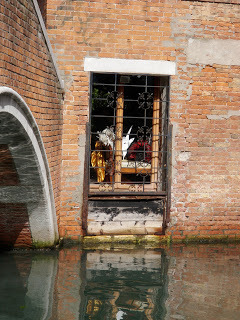 The next day was a repeat of the first. Barb recounted every one of Martin’s crimes and I listened, but this time we were walking along waterways, up and over the Bridge of Sighs and past shops selling gold jewelry, Carnival masks and glass works. Every once in a while I would point out something to Barb, just to get her eyes off the dusty ground in front of her.
The next day was a repeat of the first. Barb recounted every one of Martin’s crimes and I listened, but this time we were walking along waterways, up and over the Bridge of Sighs and past shops selling gold jewelry, Carnival masks and glass works. Every once in a while I would point out something to Barb, just to get her eyes off the dusty ground in front of her.
I finally got a break from her chatter in a glass shop. I admired the craftsmanship that went into the goblets, but my budget was tiny. My husband and I could barely afford his schooling and the trip, so I turned my attention to the “seconds” table when I heard something surprising.
“I love this,” said Barb, holding a glass pen in her hand.
I turned it over for the price tag. “It’s just ten dollars, so buy it.” I knew from listening to Barb that she had amassed a fortune for herself and her husband, although he did not appreciate her penny-pinching talent.
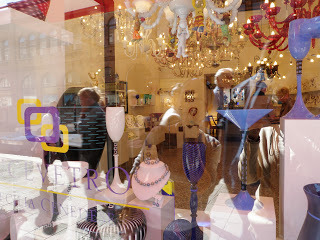 Barb held the clear instrument to the light off the canal. “I’ve always wanted something special to write a book with.”
Barb held the clear instrument to the light off the canal. “I’ve always wanted something special to write a book with.”
While she mulled, I bought a handful of bracelets with the fewest number of deformed beads. When we left the shop I asked Barb about the pen that she surely must have bought.
“I didn’t buy it,” she said, resuming her pace and recounting of her husband’s crimes.
At dinner that night I finally broke over a glass of wine. “Just divorce him.”
She startled as if coming awake. "Divorce him?” She looked at her plate of ravioli. “Well, I guess I could. I probably should. Yes, I will divorce him.” She raised her water glass and we toasted her decision. “I’ll finally be happy. He can date coeds and we can split the property.” She took off, detailing her future divorce. Every plan she made was a thousand times happier than the misery she had sown earlier.
The next morning I awoke early and saw her eating a candy bar on her bed. “People came by all night long to buy candy out of the machine below us. It kept me awake.”
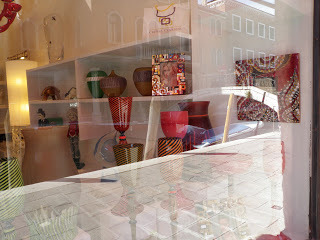 “I have to get something,” I said, quickly changing into a skirt and sleeveless blouse. Out on the street, I walked past the candy machine for the nearest glass store. This shop was in the hotel district, so the prices were triple those we had seen a day earlier. But this was a special purchase. Back in our room, I handed over the narrow package. “I had to get this for you.”
“I have to get something,” I said, quickly changing into a skirt and sleeveless blouse. Out on the street, I walked past the candy machine for the nearest glass store. This shop was in the hotel district, so the prices were triple those we had seen a day earlier. But this was a special purchase. Back in our room, I handed over the narrow package. “I had to get this for you.”
Barb undid the green ribbon. “Thank you,” she said, picking apart tissue paper to find the glass pen inside.
I opened my arms for the hug I expected. “May you write and create the life you want after your divorce.”
She put the lid back on the box, re-tied the ribbon and walked over to her luggage. “I’m not getting divorced.”
I watched her pack the pen away, knowing there would be no book written with that instrument. It would be forever locked away in its little coffin tied with green ribbon, a frozen symbol of her life, stuck and waiting for something. Something that might never happen.
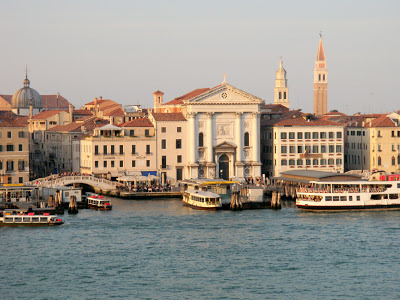 Janette Turner is a writer, reporter, and memoir coach. You can read more of her work at www.JanetteTurner.com.
Janette Turner is a writer, reporter, and memoir coach. You can read more of her work at www.JanetteTurner.com.

One summer I traveled to Italy with my husband’s business school and set out on a side trip to Venice. My companion was another wife amusing herself while her spouse was in class. As I sat in the back seat of a student's rental car next to Barb, she revealed why all the other wives had gone off without us.
 “Slow down!" said Barb every few minutes, even though the young driver was motoring in the right lane, letting cars pass. Soon there were so many admonishments and complaints from Barb that I realized I was reflexively cringing whenever she opened her mouth. She seemed to have the same displeased opinion about everything, including the short ride on the train and the choppy water against the sides of the Vaporetto that finally arrived. Most of all, she complained about her husband. “Martin flirts with the coeds and doesn’t seem to notice me.”
“Slow down!" said Barb every few minutes, even though the young driver was motoring in the right lane, letting cars pass. Soon there were so many admonishments and complaints from Barb that I realized I was reflexively cringing whenever she opened her mouth. She seemed to have the same displeased opinion about everything, including the short ride on the train and the choppy water against the sides of the Vaporetto that finally arrived. Most of all, she complained about her husband. “Martin flirts with the coeds and doesn’t seem to notice me.” I nodded in sympathy while leading us down the alley to our budget hotel. Opening the door to our room, I was shocked to see a chandelier and gilding on the bathroom fixtures. The floor at my feet was a mosaic of marble. “This room is divine.”
 Barb looked around. “It’s dirty,” she said and continued her list of marital complaints. At one point she abandoned the subject to discuss dinner. “I don’t care where we eat as long as it’s cheap.”
Barb looked around. “It’s dirty,” she said and continued her list of marital complaints. At one point she abandoned the subject to discuss dinner. “I don’t care where we eat as long as it’s cheap.”As we wandered an alley, I read menus posted under strings of white lights outside restaurants. Over pasta and tap water, Barb continued her husband’s crimes against their marriage, from forgetting her 50th birthday to drinking too much vodka. She waved away the waiter’s platter of desserts and, still talking about Martin, marched us back to our gilded room.
 The next day was a repeat of the first. Barb recounted every one of Martin’s crimes and I listened, but this time we were walking along waterways, up and over the Bridge of Sighs and past shops selling gold jewelry, Carnival masks and glass works. Every once in a while I would point out something to Barb, just to get her eyes off the dusty ground in front of her.
The next day was a repeat of the first. Barb recounted every one of Martin’s crimes and I listened, but this time we were walking along waterways, up and over the Bridge of Sighs and past shops selling gold jewelry, Carnival masks and glass works. Every once in a while I would point out something to Barb, just to get her eyes off the dusty ground in front of her. I finally got a break from her chatter in a glass shop. I admired the craftsmanship that went into the goblets, but my budget was tiny. My husband and I could barely afford his schooling and the trip, so I turned my attention to the “seconds” table when I heard something surprising.
“I love this,” said Barb, holding a glass pen in her hand.
I turned it over for the price tag. “It’s just ten dollars, so buy it.” I knew from listening to Barb that she had amassed a fortune for herself and her husband, although he did not appreciate her penny-pinching talent.
 Barb held the clear instrument to the light off the canal. “I’ve always wanted something special to write a book with.”
Barb held the clear instrument to the light off the canal. “I’ve always wanted something special to write a book with.” While she mulled, I bought a handful of bracelets with the fewest number of deformed beads. When we left the shop I asked Barb about the pen that she surely must have bought.
“I didn’t buy it,” she said, resuming her pace and recounting of her husband’s crimes.
At dinner that night I finally broke over a glass of wine. “Just divorce him.”
She startled as if coming awake. "Divorce him?” She looked at her plate of ravioli. “Well, I guess I could. I probably should. Yes, I will divorce him.” She raised her water glass and we toasted her decision. “I’ll finally be happy. He can date coeds and we can split the property.” She took off, detailing her future divorce. Every plan she made was a thousand times happier than the misery she had sown earlier.
The next morning I awoke early and saw her eating a candy bar on her bed. “People came by all night long to buy candy out of the machine below us. It kept me awake.”
 “I have to get something,” I said, quickly changing into a skirt and sleeveless blouse. Out on the street, I walked past the candy machine for the nearest glass store. This shop was in the hotel district, so the prices were triple those we had seen a day earlier. But this was a special purchase. Back in our room, I handed over the narrow package. “I had to get this for you.”
“I have to get something,” I said, quickly changing into a skirt and sleeveless blouse. Out on the street, I walked past the candy machine for the nearest glass store. This shop was in the hotel district, so the prices were triple those we had seen a day earlier. But this was a special purchase. Back in our room, I handed over the narrow package. “I had to get this for you.”Barb undid the green ribbon. “Thank you,” she said, picking apart tissue paper to find the glass pen inside.
I opened my arms for the hug I expected. “May you write and create the life you want after your divorce.”
She put the lid back on the box, re-tied the ribbon and walked over to her luggage. “I’m not getting divorced.”
I watched her pack the pen away, knowing there would be no book written with that instrument. It would be forever locked away in its little coffin tied with green ribbon, a frozen symbol of her life, stuck and waiting for something. Something that might never happen.
 Janette Turner is a writer, reporter, and memoir coach. You can read more of her work at www.JanetteTurner.com.
Janette Turner is a writer, reporter, and memoir coach. You can read more of her work at www.JanetteTurner.com.
Published on December 13, 2012 08:40
November 28, 2012
THE ICE MAN
It was disturbing to gaze into the vacant eyes of a 5500-year-old man who could possibly be one of my most distant ancestors.
Otzi, as he is known after the location where he turned up, is sleeping in the northern Italian city of Bolzano between Verona and the Brenner Pass. But Otzi doesn’t rest in peace because he was a murder victim in a case that will never be solved, and because some scientist or another is always wanting to study him or check on his health. It wasn't good at the time of death – at about age 46 he was arthritic, infested with whipworms, was lactose intolerant, suffered from Lyme disease and arteriosclerosis. On the other hand he didn’t have tooth cavities. Currently the concerns involve worries that fungus will eventually eat into the body and destroy it.
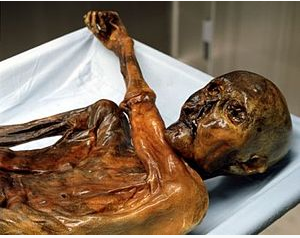
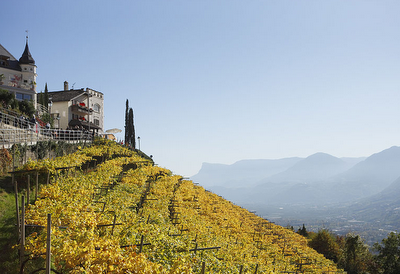 The area of the South Tyrol in the northern part of Italy was in Austria before the end of World War I and is still heavily German in culture. It is one of the most beautiful regions – full of vineyards spilling down the slopes, clear rivers and streams and many winter and summer resorts. We were staying in the lovely town of Bressanone, or Brixen as it is known in German, when we heard about the mummy. We headed south for the short drive down to Bolzano to visit him.
The area of the South Tyrol in the northern part of Italy was in Austria before the end of World War I and is still heavily German in culture. It is one of the most beautiful regions – full of vineyards spilling down the slopes, clear rivers and streams and many winter and summer resorts. We were staying in the lovely town of Bressanone, or Brixen as it is known in German, when we heard about the mummy. We headed south for the short drive down to Bolzano to visit him.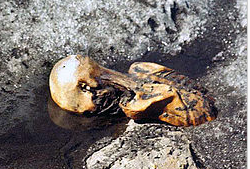 Not a mummy like those in Egypt, bandage wrapped with their internal organs removed to jars, Otzi is nearly whole – except for his penis reportedly stolen when he emerged from the ice on the Italian-Austrian border in 1991.
Not a mummy like those in Egypt, bandage wrapped with their internal organs removed to jars, Otzi is nearly whole – except for his penis reportedly stolen when he emerged from the ice on the Italian-Austrian border in 1991. Now he reclines in a refrigerated case where visitors can look at him, and in a separate section study a life-size model and his clothing and tools. He wore a loincloth of goatskin and a overcoat made of long strips of the same skin fashioned with alternating dark and light colors held together with animal sinews. The coat was closed with a decoratively-stitched calfskin belt. His leggings, also of goat, are similar in style to those worn by North American Indians. His laced shoes, no doubt also Italian high-style at the time, are like booties stuffed with hay for warmth. The sole is made of bear, fur-side in. The upper part, with hair turned out, is deerskin. The ensemble was finished with a plaited grass cloak and a bearskin cap to be tied under his chin.
No different than the rest of us he had jewelry – a tassel with a marble bead. He also carried two birch bark containers that may have been used for embers, and a food supply: smoked ibex meat, einkorn (like farro) and sloe berries. Along with these items were two clumps of birch fungus, an anti-bacterial compound used to heal wounds well into the 20th century.
Otzi died sometime between 3350 and 3100 B.C., long before the Pyramids of Giza were built in Egypt. Despite being armed with a bow and arrows, a dagger and an axe made of almost pure copper, he lost a fight for his life after bleeding to death from a stone arrow lodged in his back along with other wounds. A lonely and painful death high in the Alpine snowfields, far from kin and hearth.
Of course we can’t know where he was going or why but it has been determined that his ancestors came from the Mediterranean, most likely Sardinia or Corsica. And he might have had some Neanderthal ancestry.

What a strange feeling it was to look at him. Egyptian mummies are interesting because of the elaborate burial rites surrounding them but this was different. Here was a real European preserved by Nature, a possible far distant relative, a traveler like me, and a window into the remote past which isn’t really so different from our lives after all.
Published on November 28, 2012 14:07
November 1, 2012
GOING TO THE DOGS
It was a long way to travel to see sled dogs – well, I admit that it wasn’t the only reason for the trip but it was one of the more interesting stops along the way.
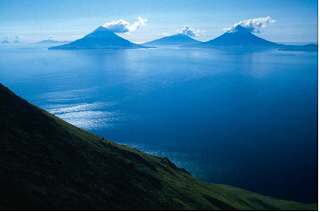 We left Kodiak Island in a huge storm with an ocean-going tug escorting us because of jagged rocks so close to the ship I felt we could have stepped off for a hike if we were feeling foolhardy. By morning the weather was clear and the Aleutian Islands were off to starboard. Snow-capped volcanoes were smoking lazily; just an occasional puff from their pipes seemed to content them. The ship turned north to enter the Bering Sea.
We left Kodiak Island in a huge storm with an ocean-going tug escorting us because of jagged rocks so close to the ship I felt we could have stepped off for a hike if we were feeling foolhardy. By morning the weather was clear and the Aleutian Islands were off to starboard. Snow-capped volcanoes were smoking lazily; just an occasional puff from their pipes seemed to content them. The ship turned north to enter the Bering Sea. photo courtesy of wilderness.net
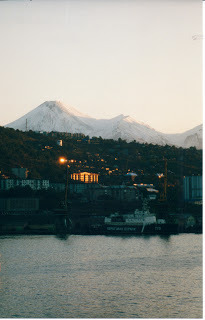 Despite my fears of bad weather and having visions of a Deadliest Catch experience the sea was like glass, so smooth that the few clouds were reflected in the water making a magical scene where sea and sky were one. By afternoon the water was ruffled with whales blowing and millions of seabirds fluttering and diving. A few fishing boats were on the horizon, otherwise just a vast emptiness on all sides.
Despite my fears of bad weather and having visions of a Deadliest Catch experience the sea was like glass, so smooth that the few clouds were reflected in the water making a magical scene where sea and sky were one. By afternoon the water was ruffled with whales blowing and millions of seabirds fluttering and diving. A few fishing boats were on the horizon, otherwise just a vast emptiness on all sides. 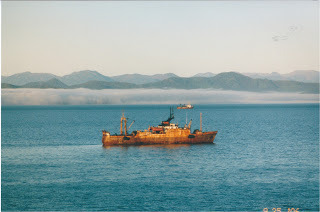 A few days later we entered Avacha Bay on the southern end of the Kamchatskya Peninsula in Russia. The bay, overlooked by two towering volcanoes and snow-capped mountains, was still in dawn shadow. Shortly after a brilliant sun rose to light up the cloudless sky, the snowy mountains and the bright orange rust on old freighters resting in an eternal sleep while they rotted at anchor. A layer of fog hugged the ground to soften the scene.
A few days later we entered Avacha Bay on the southern end of the Kamchatskya Peninsula in Russia. The bay, overlooked by two towering volcanoes and snow-capped mountains, was still in dawn shadow. Shortly after a brilliant sun rose to light up the cloudless sky, the snowy mountains and the bright orange rust on old freighters resting in an eternal sleep while they rotted at anchor. A layer of fog hugged the ground to soften the scene. 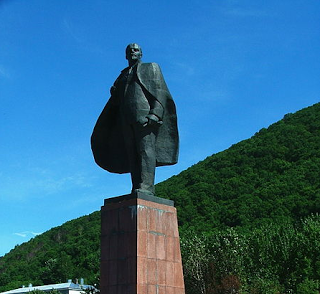
We docked at Petropavlesk. The Siberian city is 4200 miles from Moscow on the map but with no roads that would actually allow you to drive there. It was founded by the Danish explorer, Vitus Bering in 1740 who named it after his two ships, St. Peter and St. Paul. Despite its age the city of 180,000 had an element of the Wild West, low on the traffic-signal quotient and with a ramshackle aspect.
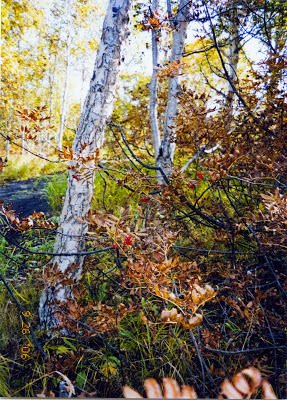 We climbed in a van, passed the inevitable statue of Lenin, gazing with determination toward who knows what now, and headed out of town, passing under steam-heating pipes arching the streets. It wasn’t long before we were in the countryside where birch trees and shrubs wearing fall bronze and gold leaves covered the hills. Turning off the road we traveled toward a sled dog training center, our goal for the day. A chorus of frantically barking dogs announced our arrival at a tiny cluster of buildings – the kennel, lodge and outbuildings and a few dachas surrounded with gardens of cabbages. Guarding the sight was one of the snowy volcanoes. The air was so still that its smoke plume looked like a white feather stuck on top for decoration before it dissipated.
We climbed in a van, passed the inevitable statue of Lenin, gazing with determination toward who knows what now, and headed out of town, passing under steam-heating pipes arching the streets. It wasn’t long before we were in the countryside where birch trees and shrubs wearing fall bronze and gold leaves covered the hills. Turning off the road we traveled toward a sled dog training center, our goal for the day. A chorus of frantically barking dogs announced our arrival at a tiny cluster of buildings – the kennel, lodge and outbuildings and a few dachas surrounded with gardens of cabbages. Guarding the sight was one of the snowy volcanoes. The air was so still that its smoke plume looked like a white feather stuck on top for decoration before it dissipated.
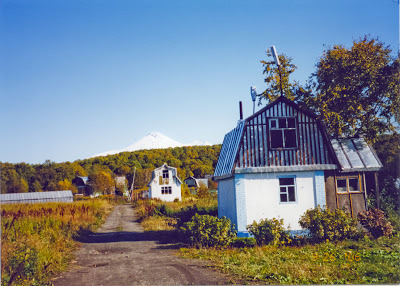
Each dog was attached to a long chain next to a small dog house. The chains were arranged so that neither dog could reach its neighbor. We stood well back as these working dogs didn’t wag their tails or smile. But the puppies – what a treat to cuddle them even knowing that they would never be anyone’s pets.
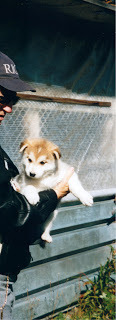
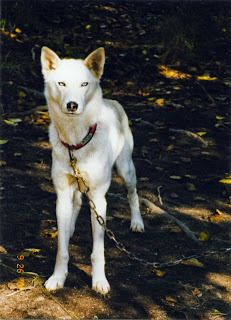
While fresh-caught salmon was grilling we looked at the native clothing and dog harness displayed in the lodge and foraged for berries and mushrooms along the paths leading to the wilderness of Siberia.
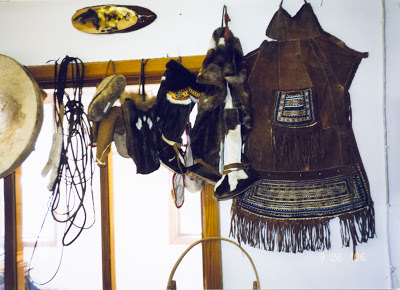
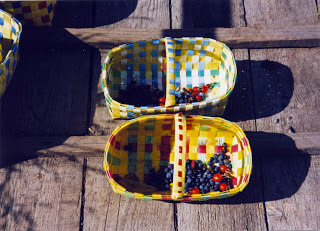
We could hear the dogs barking frantically, so agitated that they were jumping straight up until their chains jerked them back to the ground; they knew what was next on the agenda. Lunchtime over, the trainer brought out a sled with wheels for off-season use. As he held up the harness each dog seemed to be yelling “Take me, take me.” He picked six dogs who rushed to the sled to be set in the traces. The trainer stepped on the back and off they went, so fast that we could hardly take a photo. The wheels of the sled bounced off the ground threatening to throw the driver into the dirt of the rough track. Back and forth, around and around the track the dogs ran with joy, their mates still at the kennel barking encouragement and longing for snow, not far away on this late September day.
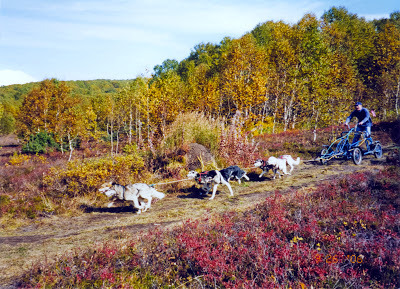
Born to run.
Published on November 01, 2012 11:13
October 17, 2012
WHERE THE GOLDEN HORN MEETS THE BOSPHORUS
Guest post from David Joslyn:
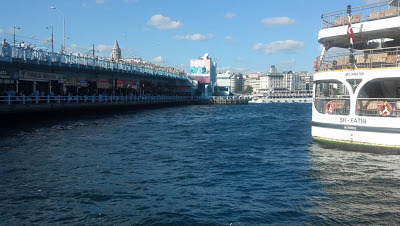 Finding the Galata Bridge on your first visit to Istanbul is like discovering the center of the universe, where dozens of cargo barges, huge water taxis and tourist cruise ships crisscross the golden Horn that flows under it in a never ending mish mass of maritime movement, a constant flow of ocean vessels visible in the distance carrying oil and grain, sharing the narrow Bosphorus passage with naval ships of all sizes as they move from the Mediterranean through the Sea of Marmara to the Black Sea and back. One of the busiest and most exciting trading centers in the world, where the past races by the present, full steam into the future, where Europe and Asia blend together in a cacophony of colorful dress, multiple cultures, and a myriad of languages, Istanbul represents a Turkey hell-bent on being a constructive player on the World stage.
Finding the Galata Bridge on your first visit to Istanbul is like discovering the center of the universe, where dozens of cargo barges, huge water taxis and tourist cruise ships crisscross the golden Horn that flows under it in a never ending mish mass of maritime movement, a constant flow of ocean vessels visible in the distance carrying oil and grain, sharing the narrow Bosphorus passage with naval ships of all sizes as they move from the Mediterranean through the Sea of Marmara to the Black Sea and back. One of the busiest and most exciting trading centers in the world, where the past races by the present, full steam into the future, where Europe and Asia blend together in a cacophony of colorful dress, multiple cultures, and a myriad of languages, Istanbul represents a Turkey hell-bent on being a constructive player on the World stage.
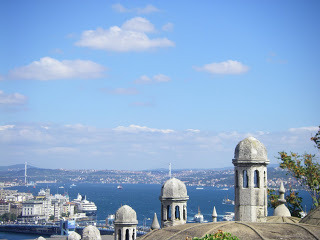 Majestically guarding the narrow space between the historically rich Sultanahmet, Seraglio Point, and the Bazaar Quarters of the city with its majestic Topkapi Palace, endlessly chaotic Grand Bazaar, imposing Hagia Sophia, spacious Suleymaniye mosque and quietly overwhelming Blue mosque on one side, and the more modern albeit funky, occasionally Bohemian Beyoglu Hill on the other side, stands the two tiered Galata Bridge over which armies of people walk, drive, and ride the buses and trams every day to get to work, shop, or sightsee, like us on a warm day in September, on our recent visit to Turkey. This bridge, and the Karakoy and Eminonu neighborhoods at each end, from where the huge passenger ferries take off for Asian Istanbul, is the sweet spot of this city, where a variety of wonderful traditional food begs you to stop, sit, rest awhile, and eat.
Majestically guarding the narrow space between the historically rich Sultanahmet, Seraglio Point, and the Bazaar Quarters of the city with its majestic Topkapi Palace, endlessly chaotic Grand Bazaar, imposing Hagia Sophia, spacious Suleymaniye mosque and quietly overwhelming Blue mosque on one side, and the more modern albeit funky, occasionally Bohemian Beyoglu Hill on the other side, stands the two tiered Galata Bridge over which armies of people walk, drive, and ride the buses and trams every day to get to work, shop, or sightsee, like us on a warm day in September, on our recent visit to Turkey. This bridge, and the Karakoy and Eminonu neighborhoods at each end, from where the huge passenger ferries take off for Asian Istanbul, is the sweet spot of this city, where a variety of wonderful traditional food begs you to stop, sit, rest awhile, and eat.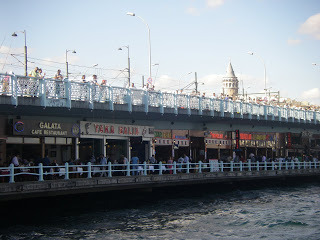 Dozens of exciting fish Lokantas (restaurants) perch along the length of the lower level of both sides of the Galata bridge, an amazing place for a cup of thick, rich coffee in the morning, a leisurely lunch, or late night multi course dinner when regulars and tourists, side by side, order platters of meze (small plate appetizers) that might include baked, sautéed or marinated sweet peppers, tomatoes, and eggplant accompanied by salad, flat bread and haidari(garlic laced yogurt). But it usually doesn’t stop there: combinations of steamed midye (mussels), grilled ahtapot(octopus), marinated calamari (squid), fried sardalya (fresh sardines) and hamsi (anchovy), and broiled levrek (sea bass, most likely farmed) and cipura (bream) all await the hungry diners.
Dozens of exciting fish Lokantas (restaurants) perch along the length of the lower level of both sides of the Galata bridge, an amazing place for a cup of thick, rich coffee in the morning, a leisurely lunch, or late night multi course dinner when regulars and tourists, side by side, order platters of meze (small plate appetizers) that might include baked, sautéed or marinated sweet peppers, tomatoes, and eggplant accompanied by salad, flat bread and haidari(garlic laced yogurt). But it usually doesn’t stop there: combinations of steamed midye (mussels), grilled ahtapot(octopus), marinated calamari (squid), fried sardalya (fresh sardines) and hamsi (anchovy), and broiled levrek (sea bass, most likely farmed) and cipura (bream) all await the hungry diners.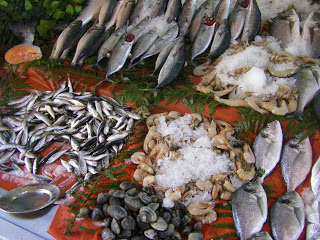
“Exciting”, rather than “Elegant”, would describe the eating experience on the Galata Bridge. So for a quieter and somewhat more upscale experience there are several places nearby, such as Pasazade, offering excellent lamb shanks on the quieter Ibni Kemal Cadessi, around the corner from the converted bath house where a stimulating dance show Hodja Pasha should not be missed. Better yet try the much acclaimed and therefore more expensive Lokanta Maya on the Karakoy side a couple of blocks up Kemankes Caddesi, making sure you order the zucchini fritters, caramelized sea bass, marinated bonito, and garlic laced shrimp. In either case, a bottle of Kavaklidere Ancyra Bogazkere or Cankaya will bring old world Anatolian grapes right to your table.
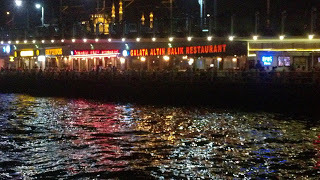
But, a prolonged stop somewhere along the seemingly mile long restaurant that is the lower level of the Galata Bridge, with its unimpeded views of the waters of the Golden Horn blending with those of the Bosphorus and a most diverse and attractive parade of humanity, will reward you with a most unforgettable sense of the vibrant heartbeat of Istanbul.
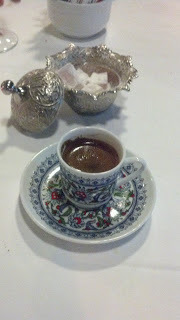
David Joslyn, having lived in Chile, Ecuador, Italy, and Costa Rica, and worked throughout the world in international development, now splits his life between Santiago, Chile, where as a Peace Corps Volunteer he married his Chilean wife Ximena, and Leesburg, Virginia. He is a private consultant who also writes leisurely about Chile, good and not-so-food, wine, and the wonderful people he has met in his travels. He blogs at: http://daveschile.blogspot.com
Published on October 17, 2012 09:32
October 9, 2012
THE GOLD COAST

This old drawing doesn't show the the Gold Coast in Australia, Long Island or Florida. It depicts Cape Coast Castle on the Gold Coast in Ghana. The gold that gave its name to the Ghanaian coastline wasn’t only the shiny metal from the African hinterland. After the establishment of plantations in the New World it was the money earned from the trade in slaves who supplied the labor that made the plantations of coffee and sugar cane so obscenely profitable.
Ghana hosts two UNESCO World Heritage Sites memorializing this horrific past, Cape Coast Castle and St George’s Castle in Elmina. Our visit to Ghana was a chance to see them. The route led us from the dock in Takoradi, piled high with manganese to be shipped to China, along the coastal road lined with a seemingly endless landscape of tiny shops and stands.

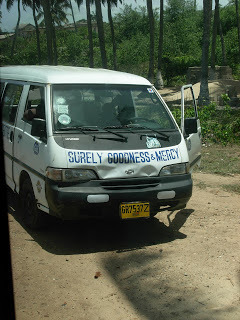 The shops were proof that despite evident poverty the spirit of enterprise was alive and well but this time led by locals, not foreign invaders. Set between flame trees and ancient crumbling Portuguese buildings the miles of shipping containers and shacks offered services of every kind. The names painted above the shop doors simply begged us to enter: God is Able Hardware, By the Grace Phone Repairs, Love of Jesus Restaurant, Adam Food Joint, Humble Works Furniture and God First Vulcanizing. Even the battered Surely Goodness and Mercy ambulance awaited business by the roadside – not for us I prayed.
The shops were proof that despite evident poverty the spirit of enterprise was alive and well but this time led by locals, not foreign invaders. Set between flame trees and ancient crumbling Portuguese buildings the miles of shipping containers and shacks offered services of every kind. The names painted above the shop doors simply begged us to enter: God is Able Hardware, By the Grace Phone Repairs, Love of Jesus Restaurant, Adam Food Joint, Humble Works Furniture and God First Vulcanizing. Even the battered Surely Goodness and Mercy ambulance awaited business by the roadside – not for us I prayed.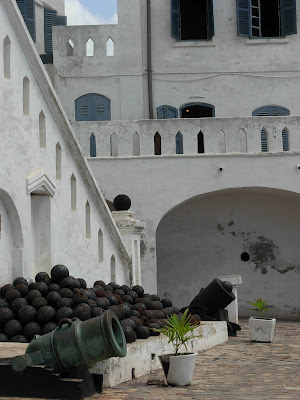 Our first stop was Cape Coast Castle where the emotional impact of what the slave trade really meant to the people involved was overwhelming. The massive two-story whitewashed fortress is one of best preserved of what had been 37 strung along a 300 mile section of the African coast where access to the interior was relatively easy. As a consequence Germans, Dutch, Danes, Portuguese, Swedes and the British battled for control, the latter eventually pushing everyone else out. Swedish traders first built a trading post for the export of timber and gold. The Dutch converted the building into a castle in 1637; after which it changed hands between the European powers five times over 13 years until the Brits grabbed it in 1664, holding on until Ghana’s independence in 1957, the first African colony to succeed in ridding themselves of overlords.
Our first stop was Cape Coast Castle where the emotional impact of what the slave trade really meant to the people involved was overwhelming. The massive two-story whitewashed fortress is one of best preserved of what had been 37 strung along a 300 mile section of the African coast where access to the interior was relatively easy. As a consequence Germans, Dutch, Danes, Portuguese, Swedes and the British battled for control, the latter eventually pushing everyone else out. Swedish traders first built a trading post for the export of timber and gold. The Dutch converted the building into a castle in 1637; after which it changed hands between the European powers five times over 13 years until the Brits grabbed it in 1664, holding on until Ghana’s independence in 1957, the first African colony to succeed in ridding themselves of overlords. 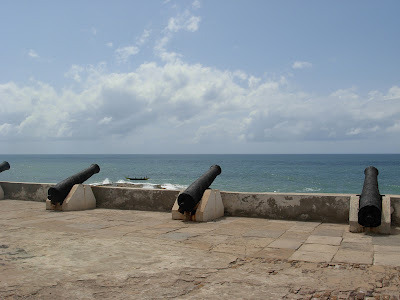 We crossed the parade ground to look at the remaining canons that still overlook the coast and to visit the room used as a chapel where the masters gave thanks on Sunday for their profits, as the source of that wealth - the captives - struggled to survive in the slave pens below. These dungeons held up to a thousand men and five hundred women at a time with no light or sanitation for up to twelve weeks as they awaited their walk through the Gate of No Return and shipment to the New World or, more likely, death on board a slave ship. It was beyond horrifying. I could not, did not want to, imagine how anyone could survive in such conditions.
We crossed the parade ground to look at the remaining canons that still overlook the coast and to visit the room used as a chapel where the masters gave thanks on Sunday for their profits, as the source of that wealth - the captives - struggled to survive in the slave pens below. These dungeons held up to a thousand men and five hundred women at a time with no light or sanitation for up to twelve weeks as they awaited their walk through the Gate of No Return and shipment to the New World or, more likely, death on board a slave ship. It was beyond horrifying. I could not, did not want to, imagine how anyone could survive in such conditions. The slave trade was abolished by Great Britain in 1808 although the Royal Navy was intercepting slavers off the African coast until 1860. I wondered what an Englishman who visited in 1835 really saw when he wrote that the castle presented a “handsome appearance…with its high white walls founded on a ledge of granite extending into the sea; and against which the bright green and white surf dashed incessantly with a heavy roar…”
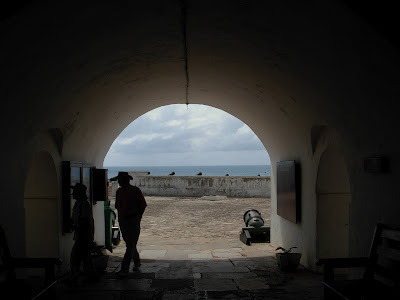
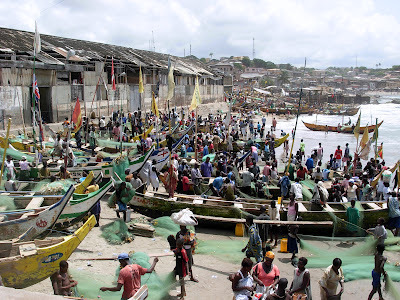 When we walked through the infamous Gate, the same green and white surf was still evident. But instead of slave ships a brilliant scene of red, blue, yellow or green striped fishing boats drawn up on the beach delighted our eyes. Seemingly heedless of the past, fishermen dried and mended their nets and women gathered the catch to take to market.
When we walked through the infamous Gate, the same green and white surf was still evident. But instead of slave ships a brilliant scene of red, blue, yellow or green striped fishing boats drawn up on the beach delighted our eyes. Seemingly heedless of the past, fishermen dried and mended their nets and women gathered the catch to take to market.
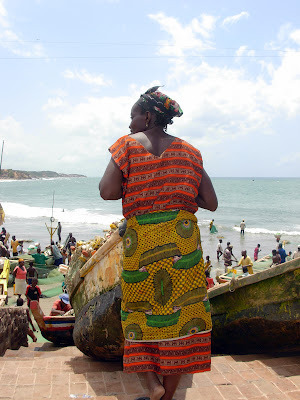
Despite this attractive scene we were lost in contemplation of the mindless cruelty always present in human existence.
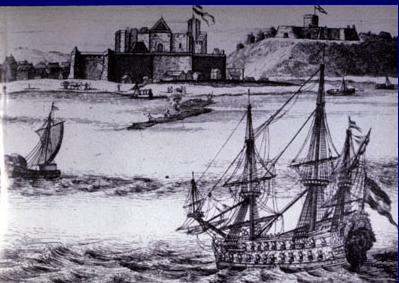
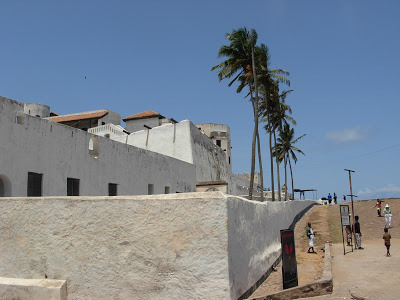 The visit to equally massive St. George's Castle in Elmina, menacing since 1482 but now brilliant white and looking innocent until we looked closely, only confirmed that human greed is an all-too-common trait and that we need to look in our own hearts on a regular basis to see what is really inside.
The visit to equally massive St. George's Castle in Elmina, menacing since 1482 but now brilliant white and looking innocent until we looked closely, only confirmed that human greed is an all-too-common trait and that we need to look in our own hearts on a regular basis to see what is really inside.Unfortunately it is much easier to look at the colorful fishing boats in the nearby port and the lovely flame trees than it is to examine one's soul.
Lest we forget.
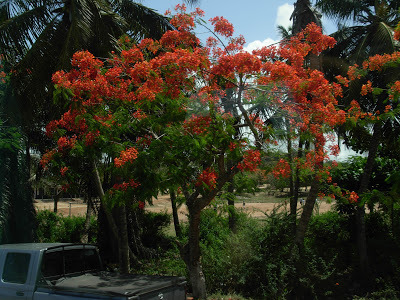
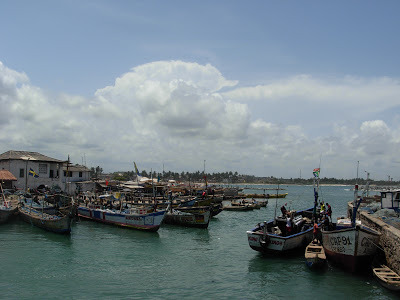
Drawings of Cape Coast and St. George's Castles courtesy of hitchock.itc.virginia.edu. Photos by author.
Published on October 09, 2012 16:20
September 26, 2012
AN ICELANDIC GARDEN
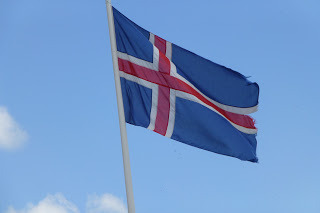
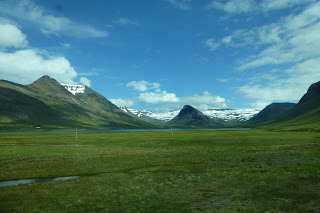 We set out from the small port town of Isafjordur on Iceland’s northwest coast, just below the Arctic Circle. The sun was out; the glaciers were sparkling, white against black. Waterfalls gushed down the steep hillsides. As we moved inland an amazing sight came into view – vast spills of purple lupines covered the grassy hillsides. The flowers are an invasive species but one that created dreamy vistas in all directions.
We set out from the small port town of Isafjordur on Iceland’s northwest coast, just below the Arctic Circle. The sun was out; the glaciers were sparkling, white against black. Waterfalls gushed down the steep hillsides. As we moved inland an amazing sight came into view – vast spills of purple lupines covered the grassy hillsides. The flowers are an invasive species but one that created dreamy vistas in all directions.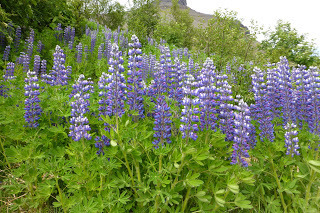
We were on tour that took us on a visit to what must be one of the more northerly gardens in the world: Skrudur, the first Icelandic botanical garden. The small walled patch of trees and flowers was planted by a priest who was assigned to the settlement of Nupur in the early 1900s. He and his wife came from even farther north and brought with them an enthusiasm for growing vegetables and a desire to teach botany and horticulture.
A small chapel and a collection of buildings, now used for a simple hotel and for live-in language courses, marked Nupur. Skrudur, a few minutes farther along, rests between the narrow Dyrafjordur fjord and a treeless plain at the base of ice-capped mountains. If we would have headed out the fjord toward the open sea we would have reached Greenland, a cold thought on a warm day.
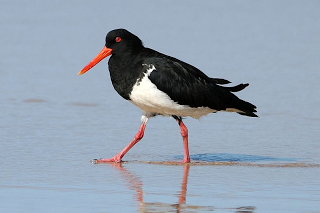
Near the shore Oystercatchers, with their red beaks, eyes and legs framing black and white bodies, walked along looking for lunch. As we walked up the path to the garden gate another type of shorebird, unknown to us, was startled from nests in the grasses. They flew around us in distress, their keening calls lending an eerie note to the scene.
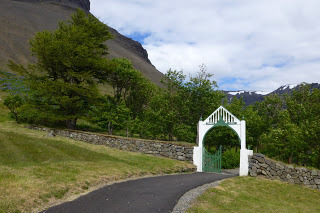
The gate’s lintel bore the date, 1909, the year the garden was officially opened. Passing through the grass-topped stone wall, we entered into a small enchanted garden, cold thoughts forgotten. Paths led us by narrow flower beds and a central fountain bubbling away. An unseen gardener had left a hose dripping creating a few puddles in the beds. Beyond the flowers was a greensward dotted with trees planted to prove that it was possible to get them to survive in the hostile climate where forest cannot survive. The trees were labeled: Sycamore, Birch, Larch, Rowan, Elm and Spruce. None had the size I associate with more temperate climes, a testament to their struggle.
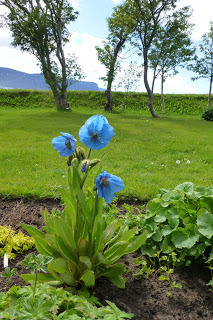
The unexpected sight of the flowers in an otherwise black, brown, green and white landscape delighted the eye. Set among the campanula, saxifrage, daisies and pansies were brilliant red, yellow and blue poppies all flourishing in the eternal daylight of
mid-summer.
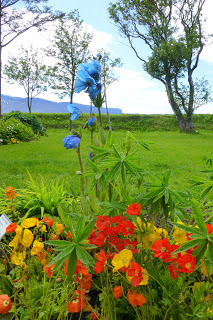
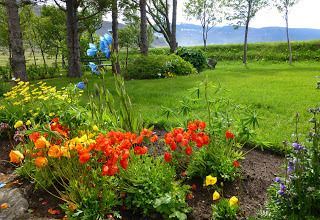
A sod-covered storage shed outside the wall on the far side of the garden was near two whalebones erected as an arch over a side entrance to the garden. They formed a parenthesis around the vista into the gardens and outward toward the mountains. A memorial to the harsh life the Icelanders have endured between land and water.
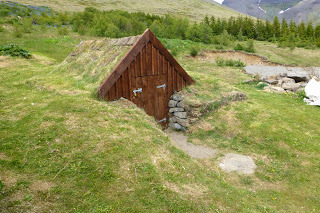
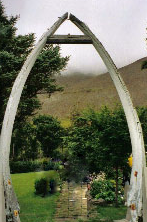
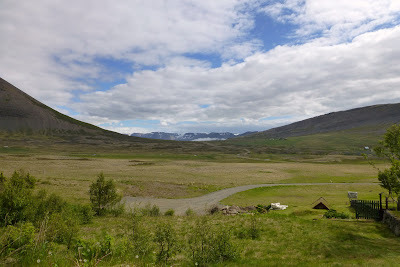
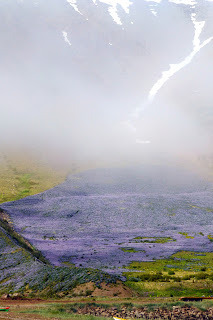
When it was time to return to Isafjordur we were treated to a mystical sight: Hovering above an immense field of lupine was a wisp of cloud. Above the moisture a mountain peak with its ice presided over the scene as if we were in Shangri-La.
Published on September 26, 2012 09:45
September 6, 2012
Floating Into Retirement
The countess was drunk again, floating motionless on her back in the warm water of the ship’s swimming pool. Wrinkled, thin and heavy with jewelry, she seemed to have an ability to remain afloat instead of sinking as the weight of her jewels would dictate. We watched her while awaiting the crew members who would haul her out on a nightly basis. During her more sober day the poor countess, who had recently suffered the theft of other jewelry from her chateau, was comforted by an Indian woman who lived in Florida. She was on board to give cooking lessons. In between dishing up curry and dal, she told us about her Irish husband who sold upscale plumbing to sheiks in the Gulf and showed us how to tie saris. She flashed around in her own bright saris encouraging us to donate money or condolences to her new best friend, the countess. We demurred.
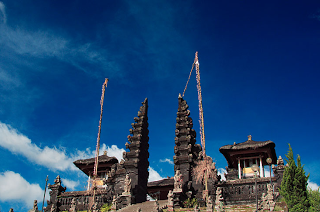
The trans-Pacific flight was interminable: Seattle to San Francisco; San Francisco to Hong Kong across the date line; then Hong Kong to Bali, another five hours. We landed in what must be the most beautiful island in the world, an oriental version of la dolce vita. A Hindu island floating in a Moslem world, it was filled with smiling people, soft gamelan music, fringed silk umbrellas, textiles woven in ikat designs, paintings and carvings. Rituals ruled the island with statues of gods draped in black and white checkered cloth symbolizing the polarity of positive and negative forces. Swastika designs on buildings and fences encouraged cosmic energy and harmony. Slender, graceful women in sarongs balanced towering offerings of fruit and rice cakes toward the split gates of the intricately carved temples. Hens and chicks pecked while fighting cocks were cooped up in upside down baskets. Rice paddies glistened green on the terraced hillsides. Tall bamboo poles leaning with the weight of small offerings decorated village streets. Small shrines stood in the fields. The soft scenes defined our vision of paradise with the gods and people in harmony even though we knew that the island had a violent history. We were tempted to stay forever like many expatriates whose villas are featured in design magazines but we could see our ship moored in the harbor awaiting us. A complete fugue
from reality was not on our itinerary.
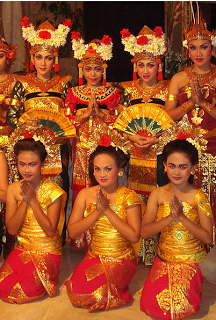
The ship was not luxurious except for the food and wine. Our floating world contained about 200 passengers, mostly Americans with some seasoning of wealthy and well-dressed Europeans. Aside from the countess and an English lord living in South Africa who always dominated the scene whenever he appeared at 11:00 a.m. at an outdoor bar to sip his bouillon, the Europeans weren’t at all interesting except for their ritzy clothes. Every evening they dressed in “smokings,” tuxedos to us, and beautiful cocktail dresses in contrast to our dresswear mostly bought at Macys. We felt distinctly lower class, which in their eyes we no doubt were. One dress-up night, however, Glenn felt a lot better about the European competition. He had reluctantly brought his own Italian tuxedo along. We were on the dance floor when he felt someone tugging at his jacket. A German was fingering the fabric. “Nice,” the man said.
The casual Americans were a mixed lot: an elderly man in the early stages of Alzheimer’s and his harried wife, permanent cruisers who told us about shipwrecks and a society formed to tell tall tales of survival (not a group we aspired to join), fat cats with fat cigars and right-wing views, and a woman celebrating her 90th birthday with her family. Also making a splash was a nasty tempered but well-dressed travel writer and her friend, equally rude and well dressed but obviously along only to fetch and carry for her aggressive boss. Completing the roster was a mother and daughter from Oklahoma. They caught our attention by spending their daylight hours lounging near the pool in the burning sun. Mother, overweight with skin like leather tanned in a pattern that included large cancer-like moles liberally scattered over the exposed parts, wore a pareo that didn’t cover enough when she left the pool. The daughter, as wide as she was tall, unfortunately favored a small bikini. She was like an upside-down pear and it was amazing that she didn’t fall over when standing.
Each day started with a wake-up call from the captain: the weather report, the port schedule if we were due to dock and then reading of ghastly doggerel written in the 1920s by the “poet,” Don Blanding. This was the signal for breakfast on deck under the spreading sun umbrellas. The days at sea were filled with Indian cooking tutorials interspersed with lectures from an over-the-hill political commentator and a self-help guru – a flashy painted woman who wore wide brimmed hats and heavy jewelry that clanked when she moved her arms. Eschewing their educational efforts, we lounged on deck watching the thousands of silvery flying fish trying to escape the bow wake. They went leaping and bouncing along like pebbles tossed in a game to see how many touch-downs could be made before finally disappearing under the water.
During our long sea days the crew frequently dined with the passengers, especially on formal evenings. Our captain was well-known by many of the Americans. They were like groupies, each one vying for his attention and crowing about whatever crumbs of attention fell their way. The captain’s table, with its flowers and premium wine, was an eagerly sought after delight. Six lucky passengers were able to sashay into the dining room escorted by the ship’s social director to be seated by their place cards while they awaited the captain’s formal entrance. Our handsome Scandinavian host, somewhat red of face, was a bon vivant who thrived on the fawning attention from his passengers. One evening the lottery selected us to share his repast, Glenn on the right and me on his left. I trotted out my best outfit which was low cut but covered by a light shawl. The captain, somewhat worse for wear, took a great interest in the shawl and worried about its arrangement. He kept turning in my direction and I could see in his eyes that he was concerned. Was it sufficient to keep my chest warm, or did the shawl need to be adjusted? He fussed, rearranging it to suit his taste, which was to have more exposure, damn the air conditioning. No one said anything although our table mates looked like they would burst trying not to laugh out loud. I tried to look like it was a normal occurrence. Glenn bore up outwardly while inwardly considering whether to smile or demand a duel at dawn on the afterdeck where trap shooting was available.
Social misadventure struck again when we were seated with the unpleasant Oklahomans and the dour Polish ship’s doctor dressed in his formal uniform with the blood-red shoulder tabs. While we ordered extra champagne to drown our sorrows at having to dine with the mother and daughter, the conversation began. Mother was swimming in oil money, the proceeds being displayed around her neck and on her fingers. She let us know that money meant nothing as she had so much of it. The daughter told us that she was employed as a bra fitter, and then, proud of her own assets (original or not) she spotted the ship’s photographer heading our way. Without missing a word in the tale of her exciting career, she grabbed both huge breasts and plopped them on the table for the photographer and us to enjoy. We were struck speechless at the crude display. Her mother didn’t notice a thing. Instead, she started on a new conversational gambit: what did ships do when a passenger died? The good doctor was then in his own glory as he told us about the morgue on every cruise ship. We skipped dessert.
Languid days slid by, each one hot and sunny with no breeze or even clouds on the horizon. The sea was usually empty but one day a small yacht came in view. The captain contacted the boat by radio learning that a family, husband, wife and small child, were on a long passage of their years-long round-the-world cruise. They had left the last port with inadequate provisions. The crew began to lower the captain’s rubber runabout. The galley crew loaded up champagne, sandwiches, fruit and more durable ships stores. The ebullient captain, always ready for some fun whether it was feeling me up, reciting poetry or joking with passengers, fired up the outboard engine and we lined the rails watching him whizzing off to deliver the sustenance with a flourish. The husband waved one of the champagne bottles in thanks. The runabout and our captain were hoisted back up and we sailed on, soon leaving the family far behind on their lonely voyage.
An inviolate sundown ritual was celebrated whenever we were far from land. Everyone gathered with their champagne glasses to watch the sunset, hoping for a glimpse of the elusive “green flash.” The flash, visible for less than a second, is an optical phenomenon when a green ray shoots up from the sunset point just as the sun sinks into the ocean. Green curves more than red/orange making that light visible after the red rays are obstructed by the curvature of the earth. The flash comes from the refraction of light as in a prism. Whenever we were rewarded with the show, a shout went up: “I saw it!”
The brilliant tropical sunset brought an end to each perfect sunny day. After dinner, we left the others to enjoy the little casino or Las Vegas-style entertainment while we sat on deck thinking of our future life and watching the stars and the white wake shimmering in the moonlight as it was endlessly left behind.
* * *
The ports of call looked as though they were set up for a photo shoot in the cruise brochure. We acted like the tourists we were, flaneurs, lounging or strolling about as onlookers, not on the boulevards of Paris but on guided tours, with little opportunity or desire to actually experience the lives we observed. This was sanitary sightseeing: food, water, accommodations and sights were all clean and neat. We were no longer expatriates or travelers.
In Java we climbed the temple of Borobudur, watched ox races and released baby turtles to the sea. In Kuala Lumpur we stood in a Chinese temple watching the paper Mercedes and houses burn during an incense laden funeral. We relaxed in rickshaws in Penang on the way to a restaurant filled with banks of orchids flourishing in the tropical damp. A stop in Phuket offered the opportunity to ride an elephant. In the Maldives we snorkeled with myriads of brightly colored little fishes before helping the chef select larger fish for dinner at the market. We took in the sights of Cochin with its canals and nearly empty Jew Town before attending a service in a Hindu temple in Mangalore where the priests rang bells, clashed cymbals and beat drums in deafening sounds to call their gods. The seething carpet of humanity in Mumbai appeared beyond the Gate of India erected by the British in the days when empires were thought to last forever.
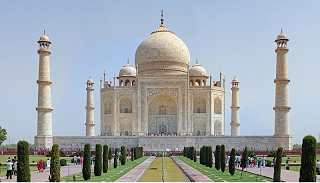 The visual highlight of the cruise was a day trip to the Taj Mahal. We flew over dry and dusty brown plains to Agra where we joined throngs on crowded roads, humans in every kind of transport available along with cows blithely ambling through traffic as we headed to the glittering white monument. Cows were a traffic hazard but provided amusement when we saw a good looking heifer with her head in a beauty shop doorway trying to see what was going on with her female counterparts.
The visual highlight of the cruise was a day trip to the Taj Mahal. We flew over dry and dusty brown plains to Agra where we joined throngs on crowded roads, humans in every kind of transport available along with cows blithely ambling through traffic as we headed to the glittering white monument. Cows were a traffic hazard but provided amusement when we saw a good looking heifer with her head in a beauty shop doorway trying to see what was going on with her female counterparts.
Built for a beloved wife who died in childbirth giving life to her fourteenth child, her husband, Shah Jahan, began the construction of the Taj in 1632. His architects and builders produced an unrivaled masterpiece of Moghul art in homage to Mumtaz Mahal, his third wife. Contrary to photographs, the building does not stand alone. Rather, we were surprised to see it is part of a complex of four magnificent buildings, each of which is an architectural marvel in itself. The entrance to the complex is white marble. Two mirror image buildings, a mosque and a guesthouse to the sides of the Taj, are red sandstone. The four buildings surround a beautiful Persian garden with fountains, pools and trees. The translucent marble exterior of the Taj is sumptuously decorated with geometric, vegetative and calligraphic designs, both carved and inlaid. Inside, to my eyes even more beautiful, are delicate marble screens surrounding the sarcophagi of the Shah and his wife. The screens are carved into lace-like shapes set with jasper, jade, turquoise, carnelian, lapis lazuli and other precious stones in designs of vines, fruit, carnations and tulips. What better evidence could there be than this monument to one of the greatest love stories of all time?
To complete the display of Indian design and in recognition that Agra was the former home of the Koh-i-Noor diamond, we visited a boutique featuring jewel encrusted Mughal jewelry. The women tried on heavy emerald, ruby and diamond necklaces and other leftovers from long-dead maharanis. We all preened for a while thinking of what it would be like to live in purdah dripping with jewels but hidden away from life outside the walls of the women’s quarters. After the modeling session, the shopkeeper, no fool he, brought out new rings, bracelets and necklaces of the same design. Women lusted and men sighed in recognition that credit cards would be extracted from their wallets. Jewelry flew off the shelves in a shopping frenzy. The English lord bought his wife a necklace of 27 large star sapphires, only emphasizing the theme of the cruise which seemed to be Jewelry Я Us. Crew members along for the excursion kept trying to push us along with little success as items flew off the shelves and into shopping bags. Not suitable for dull Seattle, I passed on the florid designs. We were late boarding the mosquito filled chartered aircraft with our treasure trove, only arriving at the ship after midnight, hours behind schedule. When we pulled up to the dock the captain was pacing back and forth in irritation. The crew held out champagne at the top of the gangplank to entice us while the ship’s orchestra played “When the Saints Come Marching In.” Obediently, we marched up the plank arms outstretched for the drink.
The engines hummed and then, hours later, at dawn, we awoke to silence. Our captain, skipping the poetry, announced that shortly after leaving Mumbai, our last port before Muscat, Oman, one of the two engines had given out due to fouling in the murky waters of the harbor. The engineers had worked all night without success. We limped ever more slowly over the Arabian Sea. Instead of a white wake, the water became increasingly oily looking as we approached the Persian Gulf. Large iridescent green globs floated on the surface reflecting a burning sun. It was hard to believe that a fabulous pearl fishery had existed for millennia in these waters, now polluted and nearly fished out.
The rocky coast appeared, ten hours late. Not a scrap of vegetation was in sight. Arab watchtowers built on the golden colored rocks looked down at us. We docked. As we were leaving the ship, the ship’s tour director informed us that the luxury hotel the cruise line had booked for everyone was not available for an unknown reason and that we would be sent to a different but slightly less famous hostelry. The English lord turned purple with rage. He screamed and he yelled and he made threatening gestures. Then he repeated the performance until the other passengers waiting patiently in the bus began to yell at him to shut up. Undeterred, he continued until he was left on the dock with his wife who probably felt that she wouldn’t be able to flaunt her sapphires in a lesser establishment.
She need not have worried. The five-star hotel was a glorious vision of the Arabian Nights. An enormous lobby was dominated by a larger than life size rotating bronze sculpture of a sheik holding a hawk on his outstretched arm while mounted on a prancing Arab stallion. Windows overlooking the beach and the Gulf of Oman were surrounded by colored glass etched with designs featuring the ceremonial rhinoceros horn handled daggers favored by the Omani men. Sculptures of elegantly horned Arabian Oryx heads hung on the walls. Zanzibar chests were topped with models of dhows.
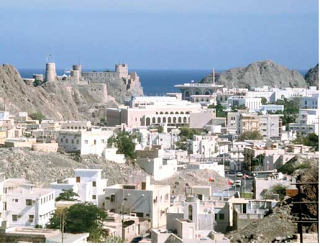 The air was heavy with the scent of frankincense – the gift of the Magi. Sensually unveiled and barely dressed Arab women lounged by the pool and handsome men in white robes and gold banded headdresses sipped coffee nearby. We visited the souk and bought coral beads. When I went to get them strung later a sniffing jeweler said they were only dyed that beautiful color.
The air was heavy with the scent of frankincense – the gift of the Magi. Sensually unveiled and barely dressed Arab women lounged by the pool and handsome men in white robes and gold banded headdresses sipped coffee nearby. We visited the souk and bought coral beads. When I went to get them strung later a sniffing jeweler said they were only dyed that beautiful color.
But some of the traders had genuine treasures:a bronze dhow manned with little figures of merchants carrying their goods to Zanzibar, their ancient trade route and former possession, and a copper bowl engraved with the name of the family who had once owned it. The little boat sits with those collected in other lands. The bowl is now filled with pomegranates, the symbol of welcome, mixed with red chili peppers for warmth, a memory of the heat of the southern lands and travel that was an introduction to retirement.


The trans-Pacific flight was interminable: Seattle to San Francisco; San Francisco to Hong Kong across the date line; then Hong Kong to Bali, another five hours. We landed in what must be the most beautiful island in the world, an oriental version of la dolce vita. A Hindu island floating in a Moslem world, it was filled with smiling people, soft gamelan music, fringed silk umbrellas, textiles woven in ikat designs, paintings and carvings. Rituals ruled the island with statues of gods draped in black and white checkered cloth symbolizing the polarity of positive and negative forces. Swastika designs on buildings and fences encouraged cosmic energy and harmony. Slender, graceful women in sarongs balanced towering offerings of fruit and rice cakes toward the split gates of the intricately carved temples. Hens and chicks pecked while fighting cocks were cooped up in upside down baskets. Rice paddies glistened green on the terraced hillsides. Tall bamboo poles leaning with the weight of small offerings decorated village streets. Small shrines stood in the fields. The soft scenes defined our vision of paradise with the gods and people in harmony even though we knew that the island had a violent history. We were tempted to stay forever like many expatriates whose villas are featured in design magazines but we could see our ship moored in the harbor awaiting us. A complete fugue
from reality was not on our itinerary.

The ship was not luxurious except for the food and wine. Our floating world contained about 200 passengers, mostly Americans with some seasoning of wealthy and well-dressed Europeans. Aside from the countess and an English lord living in South Africa who always dominated the scene whenever he appeared at 11:00 a.m. at an outdoor bar to sip his bouillon, the Europeans weren’t at all interesting except for their ritzy clothes. Every evening they dressed in “smokings,” tuxedos to us, and beautiful cocktail dresses in contrast to our dresswear mostly bought at Macys. We felt distinctly lower class, which in their eyes we no doubt were. One dress-up night, however, Glenn felt a lot better about the European competition. He had reluctantly brought his own Italian tuxedo along. We were on the dance floor when he felt someone tugging at his jacket. A German was fingering the fabric. “Nice,” the man said.
The casual Americans were a mixed lot: an elderly man in the early stages of Alzheimer’s and his harried wife, permanent cruisers who told us about shipwrecks and a society formed to tell tall tales of survival (not a group we aspired to join), fat cats with fat cigars and right-wing views, and a woman celebrating her 90th birthday with her family. Also making a splash was a nasty tempered but well-dressed travel writer and her friend, equally rude and well dressed but obviously along only to fetch and carry for her aggressive boss. Completing the roster was a mother and daughter from Oklahoma. They caught our attention by spending their daylight hours lounging near the pool in the burning sun. Mother, overweight with skin like leather tanned in a pattern that included large cancer-like moles liberally scattered over the exposed parts, wore a pareo that didn’t cover enough when she left the pool. The daughter, as wide as she was tall, unfortunately favored a small bikini. She was like an upside-down pear and it was amazing that she didn’t fall over when standing.
Each day started with a wake-up call from the captain: the weather report, the port schedule if we were due to dock and then reading of ghastly doggerel written in the 1920s by the “poet,” Don Blanding. This was the signal for breakfast on deck under the spreading sun umbrellas. The days at sea were filled with Indian cooking tutorials interspersed with lectures from an over-the-hill political commentator and a self-help guru – a flashy painted woman who wore wide brimmed hats and heavy jewelry that clanked when she moved her arms. Eschewing their educational efforts, we lounged on deck watching the thousands of silvery flying fish trying to escape the bow wake. They went leaping and bouncing along like pebbles tossed in a game to see how many touch-downs could be made before finally disappearing under the water.
During our long sea days the crew frequently dined with the passengers, especially on formal evenings. Our captain was well-known by many of the Americans. They were like groupies, each one vying for his attention and crowing about whatever crumbs of attention fell their way. The captain’s table, with its flowers and premium wine, was an eagerly sought after delight. Six lucky passengers were able to sashay into the dining room escorted by the ship’s social director to be seated by their place cards while they awaited the captain’s formal entrance. Our handsome Scandinavian host, somewhat red of face, was a bon vivant who thrived on the fawning attention from his passengers. One evening the lottery selected us to share his repast, Glenn on the right and me on his left. I trotted out my best outfit which was low cut but covered by a light shawl. The captain, somewhat worse for wear, took a great interest in the shawl and worried about its arrangement. He kept turning in my direction and I could see in his eyes that he was concerned. Was it sufficient to keep my chest warm, or did the shawl need to be adjusted? He fussed, rearranging it to suit his taste, which was to have more exposure, damn the air conditioning. No one said anything although our table mates looked like they would burst trying not to laugh out loud. I tried to look like it was a normal occurrence. Glenn bore up outwardly while inwardly considering whether to smile or demand a duel at dawn on the afterdeck where trap shooting was available.
Social misadventure struck again when we were seated with the unpleasant Oklahomans and the dour Polish ship’s doctor dressed in his formal uniform with the blood-red shoulder tabs. While we ordered extra champagne to drown our sorrows at having to dine with the mother and daughter, the conversation began. Mother was swimming in oil money, the proceeds being displayed around her neck and on her fingers. She let us know that money meant nothing as she had so much of it. The daughter told us that she was employed as a bra fitter, and then, proud of her own assets (original or not) she spotted the ship’s photographer heading our way. Without missing a word in the tale of her exciting career, she grabbed both huge breasts and plopped them on the table for the photographer and us to enjoy. We were struck speechless at the crude display. Her mother didn’t notice a thing. Instead, she started on a new conversational gambit: what did ships do when a passenger died? The good doctor was then in his own glory as he told us about the morgue on every cruise ship. We skipped dessert.
Languid days slid by, each one hot and sunny with no breeze or even clouds on the horizon. The sea was usually empty but one day a small yacht came in view. The captain contacted the boat by radio learning that a family, husband, wife and small child, were on a long passage of their years-long round-the-world cruise. They had left the last port with inadequate provisions. The crew began to lower the captain’s rubber runabout. The galley crew loaded up champagne, sandwiches, fruit and more durable ships stores. The ebullient captain, always ready for some fun whether it was feeling me up, reciting poetry or joking with passengers, fired up the outboard engine and we lined the rails watching him whizzing off to deliver the sustenance with a flourish. The husband waved one of the champagne bottles in thanks. The runabout and our captain were hoisted back up and we sailed on, soon leaving the family far behind on their lonely voyage.
An inviolate sundown ritual was celebrated whenever we were far from land. Everyone gathered with their champagne glasses to watch the sunset, hoping for a glimpse of the elusive “green flash.” The flash, visible for less than a second, is an optical phenomenon when a green ray shoots up from the sunset point just as the sun sinks into the ocean. Green curves more than red/orange making that light visible after the red rays are obstructed by the curvature of the earth. The flash comes from the refraction of light as in a prism. Whenever we were rewarded with the show, a shout went up: “I saw it!”
The brilliant tropical sunset brought an end to each perfect sunny day. After dinner, we left the others to enjoy the little casino or Las Vegas-style entertainment while we sat on deck thinking of our future life and watching the stars and the white wake shimmering in the moonlight as it was endlessly left behind.
* * *
The ports of call looked as though they were set up for a photo shoot in the cruise brochure. We acted like the tourists we were, flaneurs, lounging or strolling about as onlookers, not on the boulevards of Paris but on guided tours, with little opportunity or desire to actually experience the lives we observed. This was sanitary sightseeing: food, water, accommodations and sights were all clean and neat. We were no longer expatriates or travelers.
In Java we climbed the temple of Borobudur, watched ox races and released baby turtles to the sea. In Kuala Lumpur we stood in a Chinese temple watching the paper Mercedes and houses burn during an incense laden funeral. We relaxed in rickshaws in Penang on the way to a restaurant filled with banks of orchids flourishing in the tropical damp. A stop in Phuket offered the opportunity to ride an elephant. In the Maldives we snorkeled with myriads of brightly colored little fishes before helping the chef select larger fish for dinner at the market. We took in the sights of Cochin with its canals and nearly empty Jew Town before attending a service in a Hindu temple in Mangalore where the priests rang bells, clashed cymbals and beat drums in deafening sounds to call their gods. The seething carpet of humanity in Mumbai appeared beyond the Gate of India erected by the British in the days when empires were thought to last forever.
 The visual highlight of the cruise was a day trip to the Taj Mahal. We flew over dry and dusty brown plains to Agra where we joined throngs on crowded roads, humans in every kind of transport available along with cows blithely ambling through traffic as we headed to the glittering white monument. Cows were a traffic hazard but provided amusement when we saw a good looking heifer with her head in a beauty shop doorway trying to see what was going on with her female counterparts.
The visual highlight of the cruise was a day trip to the Taj Mahal. We flew over dry and dusty brown plains to Agra where we joined throngs on crowded roads, humans in every kind of transport available along with cows blithely ambling through traffic as we headed to the glittering white monument. Cows were a traffic hazard but provided amusement when we saw a good looking heifer with her head in a beauty shop doorway trying to see what was going on with her female counterparts.Built for a beloved wife who died in childbirth giving life to her fourteenth child, her husband, Shah Jahan, began the construction of the Taj in 1632. His architects and builders produced an unrivaled masterpiece of Moghul art in homage to Mumtaz Mahal, his third wife. Contrary to photographs, the building does not stand alone. Rather, we were surprised to see it is part of a complex of four magnificent buildings, each of which is an architectural marvel in itself. The entrance to the complex is white marble. Two mirror image buildings, a mosque and a guesthouse to the sides of the Taj, are red sandstone. The four buildings surround a beautiful Persian garden with fountains, pools and trees. The translucent marble exterior of the Taj is sumptuously decorated with geometric, vegetative and calligraphic designs, both carved and inlaid. Inside, to my eyes even more beautiful, are delicate marble screens surrounding the sarcophagi of the Shah and his wife. The screens are carved into lace-like shapes set with jasper, jade, turquoise, carnelian, lapis lazuli and other precious stones in designs of vines, fruit, carnations and tulips. What better evidence could there be than this monument to one of the greatest love stories of all time?
To complete the display of Indian design and in recognition that Agra was the former home of the Koh-i-Noor diamond, we visited a boutique featuring jewel encrusted Mughal jewelry. The women tried on heavy emerald, ruby and diamond necklaces and other leftovers from long-dead maharanis. We all preened for a while thinking of what it would be like to live in purdah dripping with jewels but hidden away from life outside the walls of the women’s quarters. After the modeling session, the shopkeeper, no fool he, brought out new rings, bracelets and necklaces of the same design. Women lusted and men sighed in recognition that credit cards would be extracted from their wallets. Jewelry flew off the shelves in a shopping frenzy. The English lord bought his wife a necklace of 27 large star sapphires, only emphasizing the theme of the cruise which seemed to be Jewelry Я Us. Crew members along for the excursion kept trying to push us along with little success as items flew off the shelves and into shopping bags. Not suitable for dull Seattle, I passed on the florid designs. We were late boarding the mosquito filled chartered aircraft with our treasure trove, only arriving at the ship after midnight, hours behind schedule. When we pulled up to the dock the captain was pacing back and forth in irritation. The crew held out champagne at the top of the gangplank to entice us while the ship’s orchestra played “When the Saints Come Marching In.” Obediently, we marched up the plank arms outstretched for the drink.
The engines hummed and then, hours later, at dawn, we awoke to silence. Our captain, skipping the poetry, announced that shortly after leaving Mumbai, our last port before Muscat, Oman, one of the two engines had given out due to fouling in the murky waters of the harbor. The engineers had worked all night without success. We limped ever more slowly over the Arabian Sea. Instead of a white wake, the water became increasingly oily looking as we approached the Persian Gulf. Large iridescent green globs floated on the surface reflecting a burning sun. It was hard to believe that a fabulous pearl fishery had existed for millennia in these waters, now polluted and nearly fished out.
The rocky coast appeared, ten hours late. Not a scrap of vegetation was in sight. Arab watchtowers built on the golden colored rocks looked down at us. We docked. As we were leaving the ship, the ship’s tour director informed us that the luxury hotel the cruise line had booked for everyone was not available for an unknown reason and that we would be sent to a different but slightly less famous hostelry. The English lord turned purple with rage. He screamed and he yelled and he made threatening gestures. Then he repeated the performance until the other passengers waiting patiently in the bus began to yell at him to shut up. Undeterred, he continued until he was left on the dock with his wife who probably felt that she wouldn’t be able to flaunt her sapphires in a lesser establishment.
She need not have worried. The five-star hotel was a glorious vision of the Arabian Nights. An enormous lobby was dominated by a larger than life size rotating bronze sculpture of a sheik holding a hawk on his outstretched arm while mounted on a prancing Arab stallion. Windows overlooking the beach and the Gulf of Oman were surrounded by colored glass etched with designs featuring the ceremonial rhinoceros horn handled daggers favored by the Omani men. Sculptures of elegantly horned Arabian Oryx heads hung on the walls. Zanzibar chests were topped with models of dhows.
 The air was heavy with the scent of frankincense – the gift of the Magi. Sensually unveiled and barely dressed Arab women lounged by the pool and handsome men in white robes and gold banded headdresses sipped coffee nearby. We visited the souk and bought coral beads. When I went to get them strung later a sniffing jeweler said they were only dyed that beautiful color.
The air was heavy with the scent of frankincense – the gift of the Magi. Sensually unveiled and barely dressed Arab women lounged by the pool and handsome men in white robes and gold banded headdresses sipped coffee nearby. We visited the souk and bought coral beads. When I went to get them strung later a sniffing jeweler said they were only dyed that beautiful color.But some of the traders had genuine treasures:a bronze dhow manned with little figures of merchants carrying their goods to Zanzibar, their ancient trade route and former possession, and a copper bowl engraved with the name of the family who had once owned it. The little boat sits with those collected in other lands. The bowl is now filled with pomegranates, the symbol of welcome, mixed with red chili peppers for warmth, a memory of the heat of the southern lands and travel that was an introduction to retirement.
Published on September 06, 2012 14:16
August 19, 2012
STROLLING ON THE STROGET
The Strøget is the longest shopping street in Europe and a delightful place to spend a sunny afternoon peering in the show windows, sipping coffee and smiling at the active street scene.
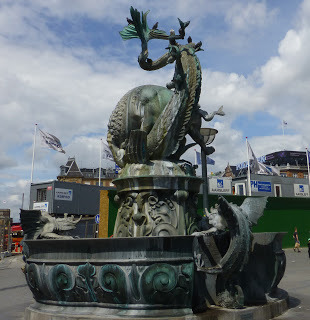
This visit I started from the Radhaus, the city hall, with its strange fountain depicting a dragon and bull furiously fighting. It stands on the side nearest Tivoli Gardens. A Viking duo eternally blowing their horns are perched far up on a pillar on the other side of the building. In between, smaller dragons guard the entrance.
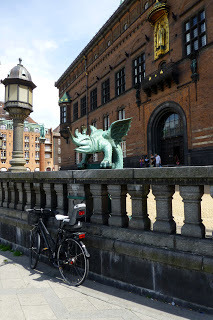
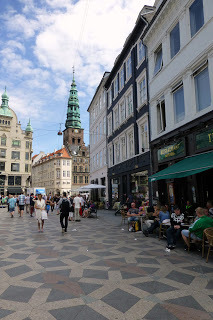
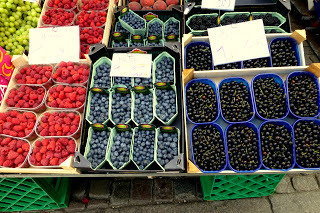 The end of the shopping street where I started my walk is home to the more modest establishments. As I ambled toward the water the prices increased with every step, finally reaching the rarified Gucci and Chanel showrooms at the harbor end of the street. The entire area was crowded with strollers looking for bargains or luxuries, enjoying the mimes and succumbing to the "Viking" shills standing outside restaurants. More tempting, several stands offered the glories of Denmark's summer bounty.
The end of the shopping street where I started my walk is home to the more modest establishments. As I ambled toward the water the prices increased with every step, finally reaching the rarified Gucci and Chanel showrooms at the harbor end of the street. The entire area was crowded with strollers looking for bargains or luxuries, enjoying the mimes and succumbing to the "Viking" shills standing outside restaurants. More tempting, several stands offered the glories of Denmark's summer bounty.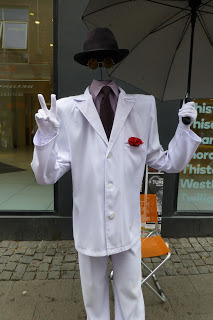
On my way was the Helligaandskirken church, one of the oldest buildings in Copenhagen. Founded in 1296, it underwent many transformations to reach its currently beautiful contours in 1880 when it was done up in Renaissance style. Over one entrance is surely what must be the most lovely lamp standard ever.
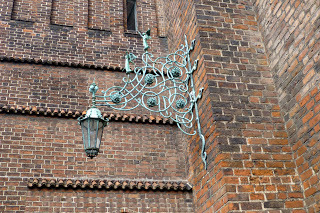
Copenhagen is a city of sculptures and two of the most beautiful are the Caritas Well and my favorite, the Stork Fountain, near my goal: the trio of Royal Copenhagen Porcelain, Georg Jensen – famous for silver; and my idea of home decorator's heaven, Illums Bolighaus, where even the most picky can find what they want. Since it’s by appointment to Her Majesty the Queen of Denmark it’s easy to be sure that it has the best of Scandinavian style.
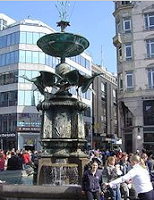
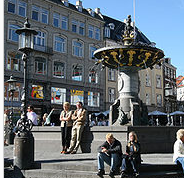
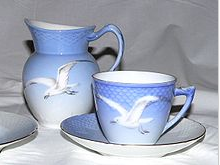 Royal Copenhagen has a design featuring seagulls floating in the blue air. I once had a beautiful and heavy dish of that design – until the day I was reaching for something and knocked it off the shelf. It fell on my head dropping me to the ground. The dish was shattered and my scalp was bleeding as I sat dazed.
Royal Copenhagen has a design featuring seagulls floating in the blue air. I once had a beautiful and heavy dish of that design – until the day I was reaching for something and knocked it off the shelf. It fell on my head dropping me to the ground. The dish was shattered and my scalp was bleeding as I sat dazed. As I was browsing around the shop a clerk was behind me fussing with a tall rolling cart filled with porcelain. Before I could get out of the way she gave it a shove. I came within a hairsbreadth of crashing into a display with the force of the impact. Not wishing for a third misadventure any future encounters will be confined to looking in their window. But not to worry: Illums Bolighaus, next door, was having a sale: bed and table linens, cookware, gorgeous glass and all manner of other wonders for the home. So I walked right in. And – yes – I staggered out with treasures to fill up the few empty spaces left in the suitcase. One was a leather shopping bag to hold yet more.
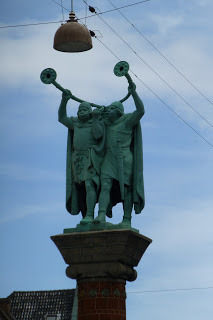 On the way back to our hotel I passed the horn-blowing Vikings again. They hadn't moved.
On the way back to our hotel I passed the horn-blowing Vikings again. They hadn't moved.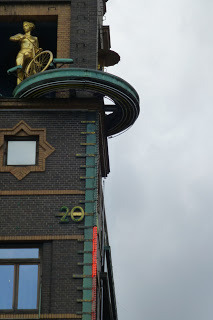
Further on I happened to look up. High on the corner of a building a golden man on a bicycle traveled in an endless circle like his human counterparts on the ground. Another of Copenhagen's delights.
Published on August 19, 2012 14:28



